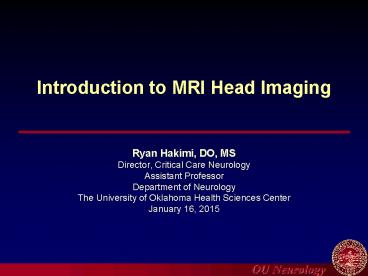Introduction to MRI Head Imaging - PowerPoint PPT Presentation
Title:
Introduction to MRI Head Imaging
Description:
Title: Acute Stroke Management Author: David Lee Gordon Last modified by: psavuser Created Date: 11/8/2002 4:13:29 PM Document presentation format – PowerPoint PPT presentation
Number of Views:98
Avg rating:3.0/5.0
Title: Introduction to MRI Head Imaging
1
Introduction to MRI Head Imaging
- Ryan Hakimi, DO, MS
- Director, Critical Care Neurology
- Assistant Professor
- Department of Neurology
- The University of Oklahoma Health Sciences Center
- January 16, 2015
2
DISCLOSURES
- FINANCIAL DISCLOSURE
- Nothing to disclose
- UNLABELED/UNAPPROVED USES DISCLOSURE
- Nothing to disclose
3
Objectives
- Describe the pros and cons of MRI versus CT when
imaging the head - Discuss some common MRI sequences
- Illustrate the appearance of acute ischemic
stroke on various MRI head sequences - Present MRI head imaging of other common
neurological diagnoses
4
Principles of Magnetic Resonance Imaging
- Uses a magnet and radio waves to create an image
based on changes in alignment of protons in the
tissue - Terminology
- Hyperintense (bright, white)
- Hypointense (dark, black)
5
Advantages of MRI over CT Head
- No radiation
- Can image in multiple planes (axial, sagital,
coronal, oblique) - Superior soft tissue imaging
- Can image some vessels without contrast (MRA
head) - Many different sequences allow for specialized
imaging - Can image the brainstem and cerebellum
6
Disadvantages of MRI vs CT Head
- Inferior bone imaging
- Cost
- Longer study time
- Images degraded by motion
- Can not image patient with pacemaker,
claustrophobia, metallic foreign bodies (bullet)
7
Axial T1
- T1 looks like a CT
- CSF is black
- (hypointense)
orbit
pons
8
Sagital T1
- atrophy
- corpus collosum
- pons
- cerebellum
9
Coronal with contrast (gadolinium)
- With contrast can see
- hyperintensity of the blood
- vessels
- Good for visualization of
- hyppocampi
10
Axial T2
- T2 has white
- (hyperintense)CSF
- lateral ventricles
- frontal horn
- occipital horn
11
DWI brainstem
- Breakdown of blood brain barrier
- acute ischemic stroke
- acute demyelination
- acute trauma
Right pontine ischemic infarction
T2 shine through
12
T2 acute ICH
- (gradient echo)
- Blood will appear black
- (hypointense)
13
Acute Ischemic StrokeDWI T1
14
Acute Ischemic Stroke T2 FLAIR
(fluid-attenuated inversion recovery)
15
Acute Ischemic StrokeT2
- petechial hemorrhages within the ischemic tissue
16
MRA (LMCA patent)
- Image can be rotated, left is not always on the
right side of the screen, must look at labels
anterior cerebral artery
middle cerebral artery
L
R
internal corotid artery
17
Normal Pressure Hydrocephalus
- Central atrophy (large
- ventricles) out of proportion to
- peripheral atrophy (minimal
- atrophy)
18
Meningioma
- Extraaxial brain tumor
- (outside of the brain) displacing
- The brain)
- Enhances with gadolinium
- Has a dural tail
19
Multiple Sclerosis
Periventricular white matter hyperintensities,
some of which enhance, from National MS Center
20
GAD with NSF
- Puts patients at risk for nephrogenic systemic
fibrosis - Fibrosis of skin, eyes, organs
- Gadolinium can not be administered in patients
- Glomerular filtration rate (GFR) of 30 or less
- On dialysis
21
Questions
- Thank you































